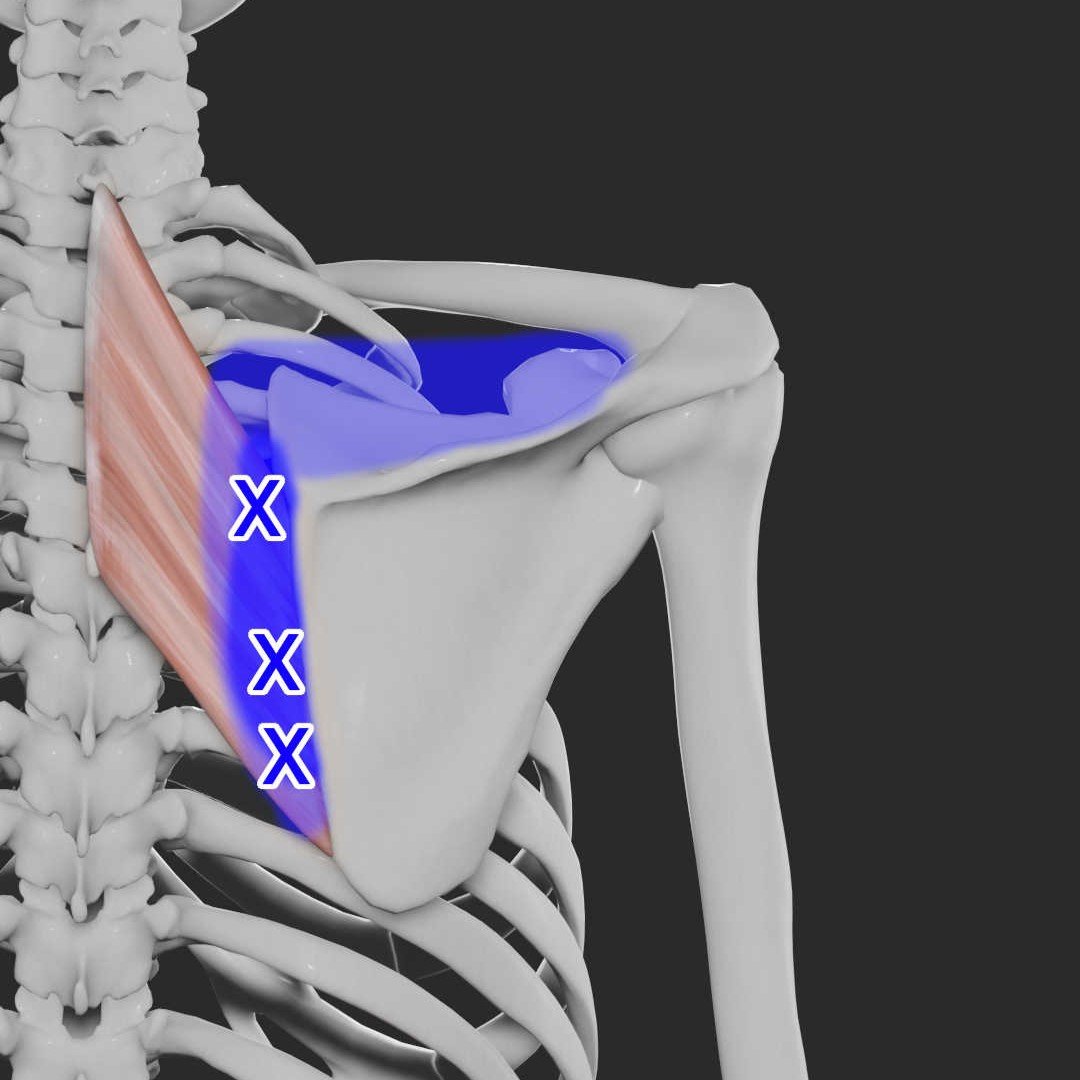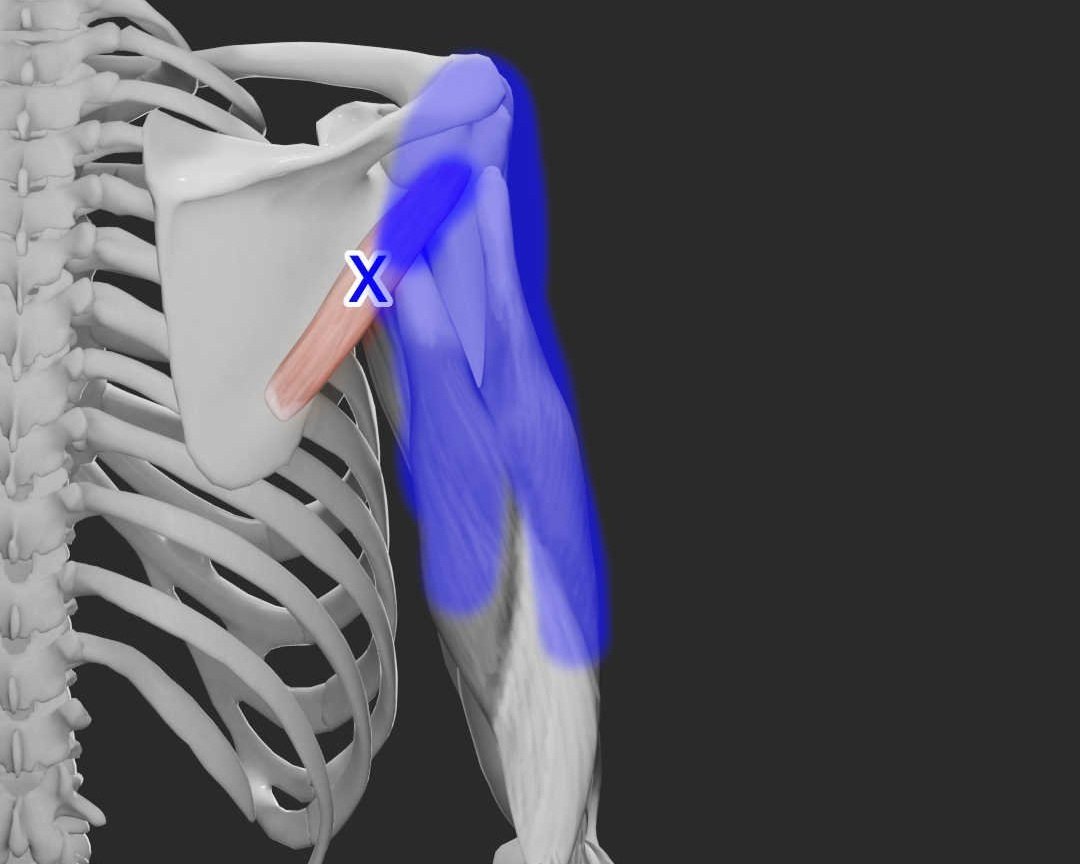Acupuncture for Rhomboid Muscle Pain
A person with shoulder blade and upper back pain
About the rhomboid muscles
The rhomboid muscles are a group of muscles located in the upper back, between the shoulder blades. They consist of the rhomboid minor and major muscles.
The rhomboid major muscle originates on the spinous process of the thoracic vertebrae (upper back) and inserts on the medial border of the scapula (shoulder blade). The rhomboid minor muscle originates on the nuchal ligament and the spinous process of the cervical vertebrae (neck) and inserts on the medial border of the scapula.
The main function of the rhomboid muscles is to retract the scapula (pull the shoulder blades together) and to stabilize the scapula against the thoracic ribcage. The rhomboids also help to rotate the scapula so the inferior angle moves upwards. The rhomboids are active during many everyday movements such as reaching, carrying objects, lifting and pushing.
Rhomboid muscle pain is often caused by trigger points, which can be released through acupuncture and dry needling. Medial shoulder blade pain and upper back pain is the most common complaint when dealing with rhomboid trigger points.
Read more to learn about rhomboid trigger points and how acupuncture and dry needling can help relieve upper back and shoulder blade pain from rhomboid trigger points naturally.
Rhomboid major origin and insertion
Rhomboid major origin:
The rhomboid major muscle origin is at the spinous processes of T-2 to T-5 in the thoracic spine.
Rhomboid major insertion:
The rhomboid major muscle insertion is at the medial border of the scapula between the spine of the scapula and the inferior angle of the scapula (shoulder blade).
Rhomboid minor origin and insertion
Rhomboid minor origin:
The rhomboid minor muscle origin is at the spinous processes of C7 and T1.
This means the rhomboid minor muscle attaches to both the cervical and thoracic spine.
Rhomboid minor insertion:
The rhomboid minor muscle insertion is at the upper portion of the medial border of the scapula, across from the spine of the scapula.
Rhomboid muscle actions
The rhomboid major and minor muscles both share the same actions of scapula adduction, scapula elevation, and downward rotation of the scapula.
Rhomboid major actions:
Adduct the scapula
Elevate the scapula
Downwardly rotate the scapula
Rhomboid minor actions:
Adduct the scapula
Elevate the scapula
Downwardly rotate the scapula
Synergists and antagonists of the rhomboid muscles
Rhomboid synergists:
Levator Scapulae: This muscle works synergistically with the rhomboids to elevate and adduct the scapula, or shoulder blade.
Trapezius: The middle and lower fibers of the trapezius muscle are synergists with the rhomboids to retract the scapula and provide stability to the shoulder joint.
Latissimus Dorsi: This muscle assists the rhomboids in retracting the scapula and adducting the shoulder.
Rhomboid antagonists:
Serratus Anterior: This muscle is the primary antagonist to the rhomboids, protracting the scapula and keeping it away from the spine.
Pectoralis Minor: This muscle also protracts the scapula, and is an antagonist to the rhomboids in their role of retracting the scapula.
Levator Scapulae: While the levator scapulae is a synergist in certain movements, it is an antagonist to the rhomboids when it elevates the scapula without retracting it.
The rhomboid muscles are deep intrinsic shoulder muscles that form the shoulder girdle along with other muscles such as sternocleidomastoid, trapezius, pectoralis, and latissimus dorsi. The rhomboids work with the serratus anterior, trapezius, and rhomboid major and minor to anchor the scapula and prevent winging. The rhomboid muscle helps stabilize the shoulder blade against the pull of the posterior deltoid, long head of the triceps brachii, and serratus anterior muscles.
There may be additional synergists or antagonists as muscle function is complex and involves groups of muscles working together. Dysfunction or muscle imbalance in synergist or antagonist muscles can affect the rhomboid muscles and lead to trigger points in them. A good treatment will address the area of pain as well as supporting areas that contribute to the pain and dysfunction.
Rhomboid Trigger Points
Main complaints related to rhomboid muscle trigger points include:
Mid-Thoracic Back Pain
Upper Thoracic Back Pain
Shoulder blade pain at the medial border
The rhomboid muscles tend to have a relatively localized referral pattern.
Associated trigger points include the pectoralis major, levator scapulae, trapezius, scalenes, latissimus dorsi, and Infraspinatus muscles.
Rhomboid Trigger Point Locations
Rhomboid trigger points can be located along the belly of the muscles. Rhomboid muscle pain is usually referred to the medial border of the scapula and between the border and vertebrae. It may also spread upward in the supraspinous area of the upper scapula
Rhomboids trigger point locations and pain referral pattern
Signs and symptoms of rhomboid trigger points
Superficial aching pain at rest near medial border of scapula that can spread to the upper scapula in the supraspinatus portion.
What causes rhomboid muscle pain?
Holding arm in abduction or flexion above 90 degrees for long time - like painting overhead
Prolonged learning forward and working in round-shoulder position like writing or sewing
Sustained shortening of pectoralis muscles
According to Travell and Simons, trigger points in the rhomboid muscles can be caused by a variety of factors, including prolonged sitting or standing, repetitive overhead movements, and direct trauma to the muscles. In addition, emotional stress can also contribute to the development of trigger points in the rhomboid muscles.
The rhomboid muscles frequently develop trigger points and pain due to prolonged stretching as a result of latent or active myofascial trigger points in the pectoralis major muscle. The contracted pectoral muscle often causes the shoulders to be pulled forward into a rounded shoulder posture, straining the weaker interscapular muscles.
Similarly, according the Vladimir Janda, sitting in a chair for extended periods of time with a slouched posture can lead to upper crossed syndrome (UCS), which causes the neck to tilt forward and the back to bend towards the rear. Individuals with UCS often experience shortened neck flexors, lower trapezius fibers, and rhomboids. The upper trapezius upper fibers, levator scapulae, pectoralis major, and pectoralis minor may also be contracted.
Such changes can increase muscle tone and stress in the neck and shoulder, leading to pain, numbness, loss of function, and other nerve root-related symptoms, ultimately impacting the function of the upper limbs. The rhomboid muscles are essential for stabilizing the scapula during contraction and extension of the shoulder joints and are important to address in cases of upper back and shoulder blade pain.
The rhomboid muscle pain pattern has some similarities to the levator scapulae pain pattern, but it does not affect the neck or restrict rotation of the neck. A snapping or crunching sensation or noise in the scapula may be from rhomboid trigger points.
A taut band present in the rhomboid muscles can be easily differentiated from the adjacent trapezius muscle by examining the orientation of its fibers. The fibers of the rhomboid muscle are angled downwards and laterally, away from the spine, while the lower fibers of the trapezius muscle are angled upwards and laterally. Meanwhile, the fibers of the middle trapezius muscle are relatively horizontal in direction.
Rhomboid muscle pain treatment for trigger points
Overall, rhomboid trigger points can be a painful and frustrating condition to deal with, but with the right treatment, patients can find relief and improve their overall quality of life. Acupuncture (and the dry needling technique) are a safe and effective therapy for treating rhomboid trigger points and can help patients to reduce pain, improve muscle function, and regain their mobility.
Your acupuncturist will identify the trigger points and taut bands of muscle that are possible sources of upper back and medial shoulder blade pain. Trigger point therapy with an acupuncture needle helps to relax the muscle to restore function, improve range of motion, and reduce pain.
Other modalities like electroacupuncture, cupping, gua sha, and tui na can also help with rhomboid trigger point symptoms.
Over to you
If you liked this article, please share with friends and family who may be suffering with upper back or shoulder blade pain.
Sources:
Travell, J. G., Simons, D. G. (1993). Myofascial pain and dysfunction: The trigger point manual. London: Lippincott Williams & Wilkins.
Biel, A., & Dorn, R. (2010). Trail guide to the body: A hands-on guide to locating muscles, bones and more. Boulder, CO: Books of Dicovery.
Janda, Vladimír. “Muscle Function Testing.” (1983).
Farrell C, Kiel J. Anatomy, Back, Rhomboid Muscles. [Updated 2022 May 20]. In: StatPearls [Internet]. Treasure Island (FL): StatPearls Publishing; 2023 Jan-.
Martin RM, Fish DE. Scapular winging: anatomical review, diagnosis, and treatments. Curr Rev Musculoskelet Med. 2008;1(1):1-11. doi:10.1007/s12178-007-9000-5
Yoo WG. Effects of pulling direction on upper trapezius and rhomboid muscle activity. J Phys Ther Sci. 2017;29(6):1043-1044. doi:10.1589/jpts.29.1043
Disclaimer: This web site is intended for educational and informational purposes only. Reading this website does not constitute providing medical advice or any professional services. This information should not be used for diagnosing or treating any health issue or disease. Those seeking medical advice should consult with a licensed physician. Seek the advice of a medical doctor or other qualified health professional for any medical condition. If you think you have a medical emergency, call 911 or go to the emergency room. No acupuncturist-patient relationship is created by reading this website or using the information. Morningside Acupuncture PLLC and its employees and contributors do not make any express or implied representations with respect to the information on this site or its use.




